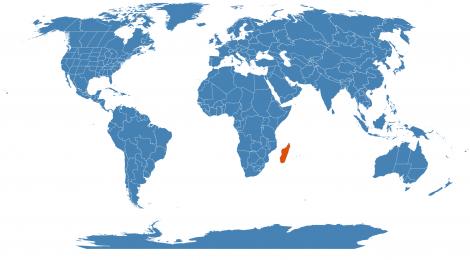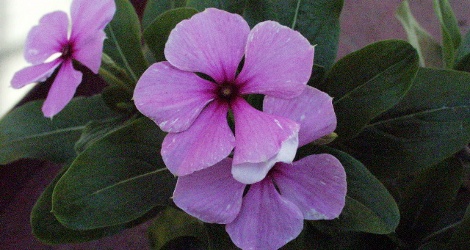Accession Data:
Catharanthus roseus (L.) G. Don
- Common Name: Rose Periwinkle
- Family: Apocynaceae Juss.
- Country of Origin: Madagascar to India

- Habitat: Found on sand and limestone soils in woodland, forest, grassland
- Description: [syn. Ammocallis rosea (L.) Small;Lochnera rosea (L.) Rchb.;Vinca rosea L.]
Has medicinal properties and is posionous when eaten by cows.
Source of the anti-tumor alkaloids vinblastine and vincristine
- Uses: In Ayurveda, this plant is considered to reduce Kapha and Vatta agitation as a drying property. All parts of the plant are used in various treatments against cancer, regulating sugar levels in the blood for diabetics, and preventing memory loss and diseases like Alzheimer's. Because of the antimicrobial properties also associated with the plant, a paste can be made with the leaves and put on insect bites/wounds.
Modern studies were conducted in testing the effectiveness of lowering glucose levels in diabetic rabbits. 6
Traditional African Remedies have used the leaves of this plant as laxatives as the plant is very toxic to both humans and animals. The plant has also been used to cure diabetes.
- IMPORTANT NOTE: Plant Uses are for informational purposes only. EEB Greenhouses assume no responsibility for adverse effects from the use of any plants referred to on this site. Always seek advice from a professional before using any plant medicinally.
- USDA Zone: 10-11
Accession Data:
- Accession # 199000018
- Source: Salo
- Recorded Vouchers:
- Voucher 217612 at George Safford Torrey Herbarium (CONN). Specimen collected 6 July 2010. Herbarium Image
- Voucher 109983 at George Safford Torrey Herbarium (CONN). Specimen collected 14 April 1997. Herbarium Image
- Accession Date: 12-31-1990
- Bench: 1120 - AFR:West Bench SS
- Currently: active - healthy
- Qty: 1 confirmed on 07-01-2025
- Restrictions:
- Poisonous Plant Parts - Not for Human Consumption
Has been shown to be toxic to livestock.
- Poisonous Plant Parts - Not for Human Consumption
Classification:
- Division: Magnoliophyta
- Class: Magnoliopsida
- SubClass: euasterid I
- Order: Gentianales
- SubOrder:
- Family: Apocynaceae
- SubFamily: Rauvolfioideae
- Tribe: Vinceae
- SubTribe:
Flowering Data:
This accession has been observed in bloom on:| Year | Jan | Feb | Mar | Apr | May | Jun | Jul | Aug | Sep | Oct | Nov | Dec | ||||||||||||||||||||||||||||||||||||||||
|---|---|---|---|---|---|---|---|---|---|---|---|---|---|---|---|---|---|---|---|---|---|---|---|---|---|---|---|---|---|---|---|---|---|---|---|---|---|---|---|---|---|---|---|---|---|---|---|---|---|---|---|---|
| 2025 | ||||||||||||||||||||||||||||||||||||||||||||||||||||
| 2024 | ||||||||||||||||||||||||||||||||||||||||||||||||||||
| 2023 | ||||||||||||||||||||||||||||||||||||||||||||||||||||
| 2022 | ||||||||||||||||||||||||||||||||||||||||||||||||||||
| 2021 | ||||||||||||||||||||||||||||||||||||||||||||||||||||
| 2020 | ||||||||||||||||||||||||||||||||||||||||||||||||||||
| 2019 | ||||||||||||||||||||||||||||||||||||||||||||||||||||
| 2018 | ||||||||||||||||||||||||||||||||||||||||||||||||||||
| 2017 | ||||||||||||||||||||||||||||||||||||||||||||||||||||
| 2016 | ||||||||||||||||||||||||||||||||||||||||||||||||||||
| 2015 | ||||||||||||||||||||||||||||||||||||||||||||||||||||
| 2014 | ||||||||||||||||||||||||||||||||||||||||||||||||||||
| 2013 | ||||||||||||||||||||||||||||||||||||||||||||||||||||
| 2012 | ||||||||||||||||||||||||||||||||||||||||||||||||||||
| 2011 | ||||||||||||||||||||||||||||||||||||||||||||||||||||
| 2010 | ||||||||||||||||||||||||||||||||||||||||||||||||||||
| 2009 | ||||||||||||||||||||||||||||||||||||||||||||||||||||
| 2008 | ||||||||||||||||||||||||||||||||||||||||||||||||||||
| 2007 | ||||||||||||||||||||||||||||||||||||||||||||||||||||
| 2006 | ||||||||||||||||||||||||||||||||||||||||||||||||||||
| 2005 | ||||||||||||||||||||||||||||||||||||||||||||||||||||
| 2004 | ||||||||||||||||||||||||||||||||||||||||||||||||||||
References (internal):
- Medicinal Plants
- Butterfly pollination (psychophily)
- Pollination Syndrome Scavenger Hunt
- EEB 3271 - Systematic Botany
- EEB 3203 - Developmental Plant Morphology
- Floriculture CDE Plant List
- Medicinal Plants - Ayurveda Medicine
- Plants with Vouchers deposited in CONN
- Medicinal Plants - Nervous System
- Medicinal Plants - Immune System
- Medicinal Plants - Traditional African Medicine
- Currently Featured Medicinal Plants
- EEB Greenhouse Holdings native to: Madagascar /
References (external):
- The Plant List (2013). Version 1.1. Last accessed on Thursday, February 01, 2018.
- WCSP (2015). World Checklist of Selected Plant Families. Facilitated by the Royal Botanic Gardens, Kew. Last accessed on Thursday, February 01, 2018.
- Catharanthus roseus at Wikipedia. Last accessed on Thursday, February 01, 2018.
- Catharanthus roseus at RBG Kew. Last accessed on Thursday, February 01, 2018.
- Catharanthus roseus at Plants for a Future. Last accessed on Thursday, February 01, 2018.
- Srinivas Nammi, Murthy K Boini, Srinivas D Lodagala and Ravindra Babu S Behara, The juice of fresh leaves of Catharanthus roseus Linn. reduces blood glucose in normal and alloxan diabetic rabbits , BMC Complementary and Alternative Medicine, 2003. Last accessed on Thursday, February 01, 2018.
data regenerated on Tue, 01 Jul 2025 11:21:26 -0400 [bcm v4.0]
Images:

Additional images for this accession:
Click on thumbnails to enlargeCurrent Accessions in the Apocynaceae
Subfamily Apocynoideae
Tribe Apocyneae
Subfamily Apocynoideae
Tribe Malouetieae
Subfamily Apocynoideae
Tribe Mesechiteae
Subfamily Apocynoideae
Tribe Nerieae
Subfamily Apocynoideae
Tribe Wrightieae
Subfamily Asclepiadoideae
Tribe Asclepiadeae
- Asclepiadinae: Asclepias curassavica


- Asclepiadinae: Asclepias tuberosa


- Asclepiadinae: Gomphocarpus fruticosus


- Cynanchinae: Cynanchum grandidieri W/C


- Cynanchinae: Cynanchum marnierianum


- Cynanchinae: Cynanchum pachycladon

- Cynanchinae: Cynanchum sp.
- Cynanchinae: Cynanchum verrucosum

Subfamily Asclepiadoideae
Tribe Ceropegieae
- Stapelieae: Caralluma hesperidum

- Stapeliinae: Ceropegia albisepta W/C

- Stapeliinae: Ceropegia ampliata


- Stapeliinae: Ceropegia ampliata


- Stapeliinae: Ceropegia aristolochioides

- Stapeliinae: Ceropegia cimiciodora
- Stapeliinae: Ceropegia fusca

- Stapeliinae: Ceropegia linearis subsp. woodii

- Stapeliinae: Ceropegia x rothii
- Stapeliinae: Ceropegia stapeliiformis


- Stapeliinae: Edithcolea grandis

- Stapeliinae: Hoodia gordonii

- Stapeliinae: Huernia piersii

- Stapeliinae: Huernia plowesii


- Stapeliinae: Huernia thureti var. thureti


- Stapeliinae: Huernia zebrina

- Stapeliinae: Larryleachia cactiformis

- Stapeliinae: Stapelia flavopurpurea


- Stapeliinae: Stapelia gigantea


- Stapeliinae: Stapelia grandiflora

- Stapeliinae: Stapelianthus madagascariensis


Subfamily Asclepiadoideae
Tribe Fockeeae
Subfamily Asclepiadoideae
Tribe Marsdenieae
- Dischidia albiflora


- Dischidia bengalensis

- Dischidia litoralis

- Dischidia major


- Dischidia ovata
- Dischidia ruscifolia

- Hoya australis ssp. australis
- Hoya carnosa


- Hoya carnosa x serpens

- Hoya curtisii
- Hoya imbricata

- Hoya imbricata

- Hoya macgillivrayi


- Hoya macrophylla

- Hoya obovata


- Hoya pubicalyx

- Hoya retusa
- Marsdenia floribunda


Subfamily Periplocoideae
Tribe Cryptolepideae
Subfamily Periplocoideae
Tribe Periploceae
Subfamily Rauvolfioideae
Tribe Alyxieae
Subfamily Rauvolfioideae
Tribe Carisseae
Subfamily Rauvolfioideae
Tribe Plumerieae
Subfamily Rauvolfioideae
Tribe Tabernaemontaneae
- Tabernaemontaninae: Tabernaemontana divaricata


- Tabernaemontaninae: Tabernaemontana elegans


Subfamily Rauvolfioideae
Tribe Vinceae
- Catharanthus roseus



- Rauvolfia serpentina


- Ochrosiinae: Ochrosia elliptica


 = indicates flowering in past 14 days
= indicates flowering in past 14 days
 = images available for this accession
= images available for this accession
 = map available for this accession
= map available for this accession
 = accession added within past 90 days
= accession added within past 90 days
